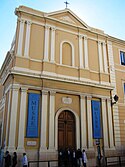
Monaco, officially the Principality of Monaco, is a sovereign city-state and microstate on the French Riviera a few kilometres west of the Italian region of Liguria, in Western Europe, on the Mediterranean Sea. It is bordered by France to the north, east and west. The principality is home to 38,682 residents, of whom 9,486 are Monégasque nationals; it is widely recognised as one of the most expensive and wealthiest places in the world. The official language of the principality is French. In addition, Monégasque, English and Italian are spoken and understood by many residents.

The economy of Monaco is reliant on tourism and banking. Monaco, situated on the French coast of the Mediterranean Sea, is a popular resort, attracting tourists to its casino and pleasant climate.
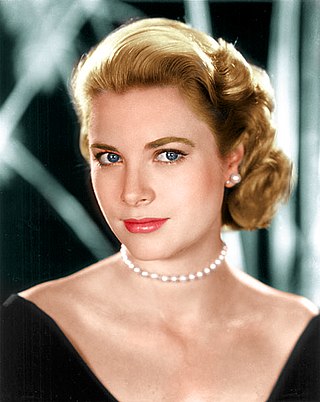
Grace Patricia Kelly, also known as Grace of Monaco, was an American actress and Princess of Monaco as the wife of Prince Rainier III from their marriage on April 18, 1956, until her death. Prior to her marriage, she starred in several significant films in the early to mid-1950s. She is known as an iconic actress of the Golden Age of Hollywood. She received an Academy Award, three Golden Globe Awards and was ranked 13th on the American Film Institute's 25 Greatest Female Stars list.
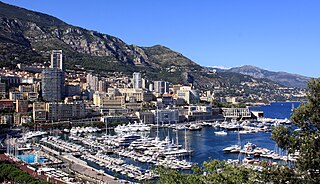
Monte Carlo is officially an administrative area of Monaco, specifically the ward of Monte Carlo/Spélugues, where the Monte Carlo Casino is located. Informally, the name also refers to a larger district, the Monte Carlo Quarter, which besides Monte Carlo/Spélugues also includes the wards of La Rousse/Saint Roman, Larvotto/Bas Moulins and Saint Michel. The permanent population of the ward of Monte Carlo is about 3,500, while that of the quarter is about 15,000. Monaco has four traditional quarters. From west to east they are: Fontvieille, Monaco-Ville, La Condamine, and Monte Carlo.
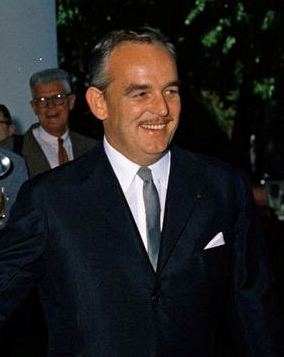
Rainier III was Prince of Monaco from 1949 to his death in 2005. Rainier ruled the Principality of Monaco for almost 56 years.
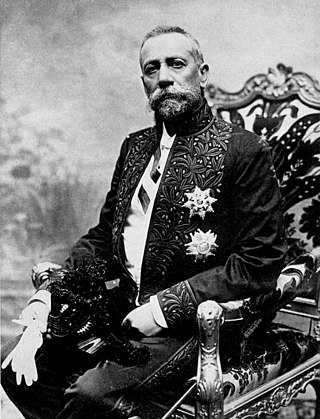
Albert I was Prince of Monaco from 10 September 1889 until his death in 1922. He devoted much of his life to oceanography, exploration and science. Alongside his expeditions, Albert I made reforms on political, economic and social levels, bestowing a constitution on the principality in 1911.

Lorenzo Monaco was an Italian painter and miniaturist of the late Gothic to early Renaissance age. He was born Piero di Giovanni. Little is known about his youth, apart from the fact that he was apprenticed in Florence. He has been considered the last important exponent of the Giotto style, before the Renaissance revolution that came with Fra Angelico and Masaccio.
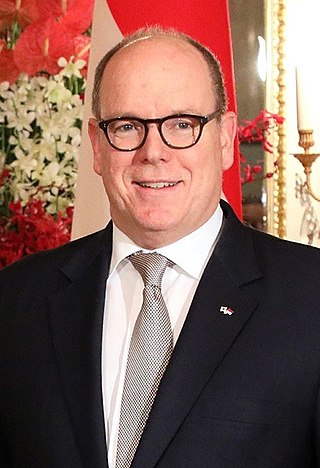
Albert II is Prince of Monaco, reigning since 2005.
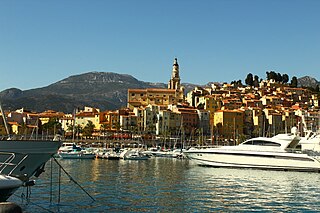
Menton is a commune in the Alpes-Maritimes department in the Provence-Alpes-Côte d'Azur region on the French Riviera, close to the Italian border.

The national flag of the Principality of Monaco has two equal horizontal bands, of red (top) and white (bottom), both of which have been the heraldic colours of the House of Grimaldi since at least 1339. The present bicolour design was adopted on 4 April 1881, under Charles III.

Fontvieille is the southernmost ward in the Principality of Monaco. It was developed by Italian engineer Gianfranco Gilardini and designed by architect Manfredi Nicoletti, between the 1970s and the 1990s.

Monaco City is the southcentral ward in the Principality of Monaco. Located on a headland that extends into the Mediterranean Sea, it is nicknamed The Rock. The name "Monaco City" is misleading: it is not itself a city, but a historical and statistical district. It holds most of the country's political and judicial institutions: the Prince's Palace, the town hall, the government, the National Council, the Municipal Council, the courts and a prison.

The Oceanographic Museum is a museum of marine sciences in Monaco-Ville, Monaco. This building is part of the Institut océanographique, which is committed to sharing its knowledge of the oceans.

The Baroque Revival, also known as Neo-Baroque, was an architectural style of the late 19th and early 20th centuries. The term is used to describe architecture and architectural sculptures which display important aspects of Baroque style, but are not of the original Baroque period. Elements of the Baroque architectural tradition were an essential part of the curriculum of the École des Beaux-Arts in Paris, the pre-eminent school of architecture in the second half of the 19th century, and are integral to the Beaux-Arts architecture it engendered both in France and abroad. An ebullient sense of European imperialism encouraged an official architecture to reflect it in Britain and France, and in Germany and Italy the Baroque Revival expressed pride in the new power of the unified state.

Péronne is a commune of the Somme department in Hauts-de-France in northern France. It is the former site of the Péronne monastery, founded by the Anglo-Saxon Eorcenwald. Its site became the resting place for St. Fursa, celebrated by the famous English historian Bede. The monastery was popular with Irish monks, among them Cellanus, whose letters to Aldhelm the Bishop of Sherborne survive. So renowned was Péronne for Irish monks that the monastery became known as Perrona Scottorum. The monastery was destroyed in a Viking raid in 880. It is close to where the 1916, first 1918 and second 1918 Battles of the Somme took place during the First World War. The Museum of the Great War is located in the château.

The following outline is provided as an overview of and topical guide to Monaco:
The International Council of Museums defines a museum as "a not-for-profit, permanent institution in the service of society that researches, collects, conserves, interprets and exhibits tangible and intangible heritage. Open to the public, accessible and inclusive, museums foster diversity and sustainability. They operate and communicate ethically, professionally and with the participation of communities, offering varied experiences for education, enjoyment, reflection and knowledge sharing.”

The Exhibition of HSH The Prince of Monaco's Car Collection is an automobile museum in the La Condamine district of Monaco.

